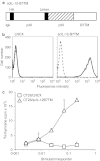Cancer immunotherapy using a membrane-bound interleukin-12 with B7-1 transmembrane and cytoplasmic domains
- PMID: 22334018
- PMCID: PMC3345985
- DOI: 10.1038/mt.2012.10
Cancer immunotherapy using a membrane-bound interleukin-12 with B7-1 transmembrane and cytoplasmic domains
Abstract
Interleukin-12 (IL-12) has potent antitumor activity, but its clinical application is limited by severe systemic toxicity, which might be alleviated by the use of membrane-anchored IL-12. In the present study, a new membrane-bound IL-12 containing murine single-chain IL-12 and B7-1 transmembrane and cytoplasmic domains (scIL-12-B7TM) was constructed and its efficacy in cancer treatment examined and its protective antitumor mechanism investigated. Surface expression of scIL-12-B7TM on colon adenocarcinoma cells significantly inhibited the growth of subcutaneous tumors, suppressed lung metastasis, and resulted in local and systemic suppression of unmodified tumors. Intratumoral injection of an adenoviral vector encoding scIL-12-B7TM not only resulted in complete regression of a majority of local tumors, but also significantly suppressed the growth of distant, untreated tumors. Moreover, mice that had been treated with scIL-12-B7TM developed memory responses against subsequent tumor challenge. Immunohistochemical staining and in vivo depletion of lymphocyte subpopulations demonstrated that both CD8(+) T cells and CD4(+) T cells contributed to the antitumor activity of scIL-12-B7TM. Importantly, the potent antitumor activities of scIL-12-B7TM were achieved with only negligible amounts of IL-12 in the circulation. Our data demonstrate that cancer immunotherapy using membrane-bound IL-12 has the advantage of minimizing systemic IL-12 levels without compromising its antitumor efficacy.
Figures








Similar articles
-
Intratumoral coinjection of two adenoviruses, one encoding the chemokine IFN-gamma-inducible protein-10 and another encoding IL-12, results in marked antitumoral synergy.J Immunol. 2000 Mar 15;164(6):3112-22. doi: 10.4049/jimmunol.164.6.3112. J Immunol. 2000. PMID: 10706701
-
Intratumoral expression of interleukin 23 variants using oncolytic vaccinia virus elicit potent antitumor effects on multiple tumor models via tumor microenvironment modulation.Theranostics. 2021 May 3;11(14):6668-6681. doi: 10.7150/thno.56494. eCollection 2021. Theranostics. 2021. PMID: 34093846 Free PMC article.
-
Spleen-derived dendritic cells engineered to enhance interleukin-12 production elicit therapeutic antitumor immune responses.Int J Cancer. 2000 Sep 1;87(5):665-72. Int J Cancer. 2000. PMID: 10925360
-
In vivo gene transfer of CD40 ligand into colon cancer cells induces local production of cytokines and chemokines, tumor eradication and protective antitumor immunity.Gene Ther. 2000 Sep;7(17):1467-76. doi: 10.1038/sj.gt.3301264. Gene Ther. 2000. PMID: 11001366
-
Antitumor and antimetastatic activity of IL-23.J Immunol. 2003 Jul 15;171(2):600-7. doi: 10.4049/jimmunol.171.2.600. J Immunol. 2003. PMID: 12847224
Cited by
-
Membrane-bound p35 Subunit of IL-12 on Tumor Cells is Functionally Equivalent to Membrane-bound Heterodimeric Single Chain IL-12 for Induction of Anti-tumor Immunity.Immune Netw. 2016 Oct;16(5):305-310. doi: 10.4110/in.2016.16.5.305. Epub 2016 Oct 25. Immune Netw. 2016. PMID: 27799876 Free PMC article.
-
Enhanced efficacy and limited systemic cytokine exposure with membrane-anchored interleukin-12 T-cell therapy in murine tumor models.J Immunother Cancer. 2020 Jan;8(1):e000210. doi: 10.1136/jitc-2019-000210. J Immunother Cancer. 2020. PMID: 31959727 Free PMC article.
-
Interleukin-12 Delivery Strategies and Advances in Tumor Immunotherapy.Curr Issues Mol Biol. 2024 Oct 16;46(10):11548-11579. doi: 10.3390/cimb46100686. Curr Issues Mol Biol. 2024. PMID: 39451566 Free PMC article. Review.
-
Combination of radiation and interleukin 12 eradicates large orthotopic hepatocellular carcinoma through immunomodulation of tumor microenvironment.Oncoimmunology. 2018 Jul 23;7(9):e1477459. doi: 10.1080/2162402X.2018.1477459. eCollection 2018. Oncoimmunology. 2018. PMID: 30228946 Free PMC article.
-
IL12 integrated into the CAR exodomain converts CD8+ T cells to poly-functional NK-like cells with superior killing of antigen-loss tumors.Mol Ther. 2022 Feb 2;30(2):593-605. doi: 10.1016/j.ymthe.2021.10.011. Epub 2021 Oct 19. Mol Ther. 2022. PMID: 34678512 Free PMC article.
References
-
- Trinchieri G. Interleukin-12 and the regulation of innate resistance and adaptive immunity. Nat Rev Immunol. 2003;3:133–146. - PubMed
Publication types
MeSH terms
Substances
LinkOut - more resources
Full Text Sources
Other Literature Sources
Research Materials

